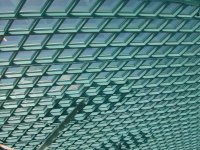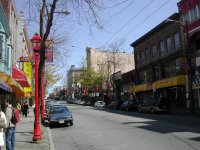
My arrival in Seattle came with some trepidation. I have fallen into the welcoming and most hospitable arms of family friends who I had never actually met until (very) early this morning. Despite a very inconvenient arrival time, I was welcomed, taken in, fed and given a bed for the night by two very kind friends of my family. I am now greatly indebted to them, and look forward to welcoming them to England some time soon.
I have a day to explore Seattle. Contrasting these short stops in big cities with my slogs on long distance trains means that I am all the more eager to explore on foot and cover lots of ground. So, after being dropped off in downtown, I make a start on criss crossing the city's clean streets on foot. A sudden rainshower sends me scuttling indoors to the nearest shopping mall, where by chance I find a small exhibition presented by the Seattle Architecture Foundation. It offers an excellent summary of some of Seattle's most important buildings, with a generous selection of models and architectural plans for me to get lost in. It's a great way to start my day.

I wander through the down town grid of streets, following my nose and peering round corners and down side alleys whenever something takes my interest. I dawdle through Pikes Market, and then walk down to the waterfront. By now the rain clouds have cleared, and the day is looking to be a beautiful one. The sky is blue, the clouds are fluffy and non-threatening in their appearance, and the temperature is picking up. I pause near the Odyssey Museum to sketch an ingenious piece of street furniture, and am entertained by (bizarrely) a trumpeter who is playing on the roof of the building. There is no explanation, not even a hat that I can leave some change in. A shame, because he was very good.
Once again I curse my itinerary - I have arrived on a Monday, when most museums are likely to be closed. However this does release me from the tourist's obligation to see everything in one go, and I feel free to just explore on foot. If one thing did come across from Seattle, however, it's that the public transport system is in a near total state of rejuvination. The Waterfront Streetcar is suspended while a new maintainance facility for the trams is built, and the city's subterranean transit tunnel is closed to allow the infrastructure for light rail to be built. So maybe this means good things are on the horizon, but I found it amusing to constantly find advisories that buses and trams weren't working or being rerouted (even more so later in the day, when the 'Day Without Immigrants' march got going).
So instead of a vintage tram, I ride a bus from pier 69 (from where you can sail by fast vessel to Victoria in British Columbia) to Chinatown - always the number one destination of the budget traveller. The streets here are broad and it's probably one of the quieter Chinatowns I've been to. But I find an attractive Vietnamese noodle bar and eat a big bowl of noodles with meatballs for $7. Full marks to the attentive waitress, who bids farewell to every customer with the same confident message:
"Thank you, see you tomorrow!"

I walk back through town, and make a detour to visit the (relatively) new Central Library, built in partnership by the Dutch architects OMA. You may already have ready my comments during my visit to
Denver about the Denver Art Museum. So you may understand my problems with landmark pieces of architecture. This is just such an example, although in exploring the building I begin to appreciate more the way in which it was designed. The floorplan has been divided into two sides, and each side is on a slight opposing slope, turning the building into a giant spiral. You can ascend by escalator to the top floor, which is a vast reading room, and then gradually descend by following a path back and forth through the gently sloping stack rooms. Or, if you are in a hurry, the elevators are fairly easy to find, and well signposted with directions to the different departments. My only concern is a rather fatal flaw. Getting caught up in creating an exciting sloping floorplan, the architects must, at some point, have realised that neither bookshelves nor filing cabinets (of which there are a lot in a library) work very well on sloping floors. So each row of shelves or drawers is held level by a small concrete plinth that breaks out of the sloping concrete floor. Great. Problem solved. Except what happens if, twenty years from now, the library needs to re-arrange the shelving units? The whole floor will have to be skimmed and re-laid to re-position the plinths for the shelves.
And if that doesn't set off alarm bells about the cost of running this exceptionally unusual building, you'll probably not be surprised to hear that the whole of the third level is closed off, as contractors lay a new floor that will (according to big signs) 'wear better'. A polite way for explaining that the architect specified a fancy, expensive and completely unsuitable material for the floors to begin with.
Nonetheless, the library impresses me. It's a nice attempt, and it seems to be very well used. Plus, for any out of town visitors, you can go to the desk by the main computer facilities, and get a voucher for an hour of free internet time.
I continue my walk through Seattle, stopping for tea again at Pikes Market, which I seem to be drawn to for its life and entertainment, and then head north towards the Space Needle. It's here that I sit in the sun (next to another unmentionable self righteous pile of bollocks architecture, a museum about music that costs $19.95 to get into and about which I really can't be bothered to waste time think about) until my lift arrives.
That night I am treated again, and we eat at a fine seafood restaurant overlooking the Puget Sound. This luxury will end again soon, but it's nice to recharge the batteries once in a while. The sun sets over the Olympic Mountains, and my brief sojourn in Seattle comes to an end.
*j*
 The real treat of the 'Canadian' can be found in the carriage behind me. On the long distance Amtrak trains I've ridden on this trip, you'll always find a 'Sightseer Lounge' car. These have extra large windows in the side, and smaller windows that curl up and over you into the roof along the length of either side of the car. While VIA Rail don't have any Sightseer Lounges, they do have a large fleet of 'Skyline' cars.
The real treat of the 'Canadian' can be found in the carriage behind me. On the long distance Amtrak trains I've ridden on this trip, you'll always find a 'Sightseer Lounge' car. These have extra large windows in the side, and smaller windows that curl up and over you into the roof along the length of either side of the car. While VIA Rail don't have any Sightseer Lounges, they do have a large fleet of 'Skyline' cars. This Skyline car is one of three in the train, not including the streamlined Park car at the very end of the train, which has it's own domed viewing deck. They're scattered through the train, with one usually every four or five coaches. Ours is just for coach passengers; the others are for the sleeper passengers in the adjacent carraiges.
This Skyline car is one of three in the train, not including the streamlined Park car at the very end of the train, which has it's own domed viewing deck. They're scattered through the train, with one usually every four or five coaches. Ours is just for coach passengers; the others are for the sleeper passengers in the adjacent carraiges.















